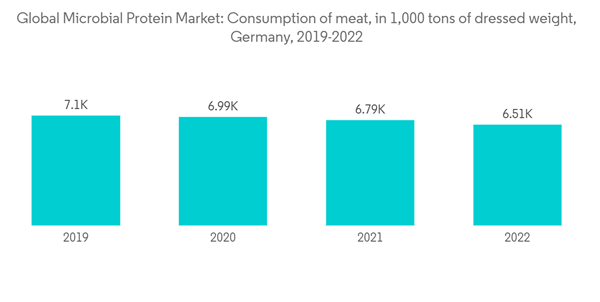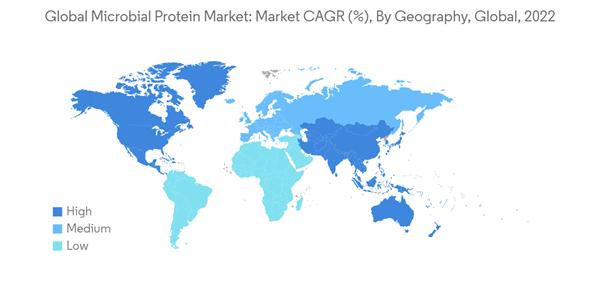Key Highlights
- The microbial protein market is an emerging and promising sector in the food and agriculture industry as these proteins have gained attention due to their potential to address various challenges faced by traditional protein sources like meat and plant-based proteins. With the increasing global demand for protein-rich foods ad the environmental concerns associated with meat production, microbial proteins offer a viable alternative to traditional animal-based proteins.
- Microbial protein production is generally considered more sustainable compared to conventional animal agriculture. It requires fewer natural resources, emits fewer greenhouse gases, and has a smaller environmental footprint. Additionally, microbial proteins can be engineered to be nutritionally rich, providing essential amino acids and other nutrients, making them attractive for meeting dietary needs.
- Moreover, advances in biotechnology and fermentation technologies have made it even easier and more cost-effective to produce microbial proteins at scale. Several technologies are used in microbial protein production, which aims to optimize the yield, quality, and efficiency of producing proteins using microbial organisms.
- For instance, genetic engineering involves modifying the genetic material of microorganisms, such as bacteria, yeast, or fungi, to enhance their ability to produce specific proteins. This could include introducing genes that encode for the target protein or manipulating the organism's metabolic pathways to boost protein production.
- Such developments happening in the market, coupled with the market players' focus on innovations and developing new products with multiple application capabilities, are expected to further boost the market's growth during the forecast period.
Microbial Protein Market Trends
Increasing Demand for Alternative Protein Sources
- Changing dietary preferences among consumers is evident globally, and the low inclination toward meat and meat-based products is visible among European and North American consumers, which is creating significant demand for alternative protein sources like microbial protein. Similarly, the percentage of consumers becoming more flexitarian or vegan has paved great opportunities for manufacturers to introduce and innovate more in the plant protein segment.
- Additionally, the demand for alternative proteins is fueled by forces ranging from health concerns to climate action and the increasing awareness of ethical issues in factory farming due to increased meat consumption. Such factors have decreased meat consumption and, thus, created space for the market to grow. For instance, according to the Federal Agency of Agriculture and Food (Bundesanstalt für Landwirtschaft und Ernährung, BLE), in 2022, around 6.5 million tons of meat were consumed in Germany, which was a decrease compared to the year before in which almost 6.8 million tons of meat were consumed.
- Such a shift in consumer demand from animal protein to plant protein can significantly contribute to the rise of the alternative protein market, including microbial protein. With this growing room for the market, several companies and startups have been working on producing microbial proteins and incorporating them into various food products.
- For instance, in May 2023, Shanghai-based Changing Bio officially debuted the company's first line of alt dairy products made with a microbial protein derived from yeast. The company launched a new ChangingPRO line, including whipped cream and a low-fat parmesan powder high in protein and probiotics featuring the novel protein Kluvy mixed with plant-based ingredients. Such factors and developments are expected to drive and support the growth of the market during the forecast period.
Asia-Pacific is The Fastest Growing Region
- Microbial protein was gaining attention and popularity in Asia, particularly in certain regions and industries. In the Asia-Pacific region, where population growth and rising demand for protein-rich foods pose significant challenges to food security and sustainability, microbial protein has been considered a potential solution. The region has seen increased interest in alternative protein sources due to concerns about environmental impact, animal welfare, and food safety.
- Notably, some countries in Asia have been early adopters of plant-based and alternative protein products, and microbial protein falls under this category. Similarly, food technology companies from various other countries and regions have been exploring the regional market and developing various microbial protein-based products, such as meat substitutes, dairy alternatives, and protein supplements. They are focused on catering to the emerging market in the region and grabbing a major market share.
- For instance, in July 2023, Israeli food tech startup Nextferm, a developer of alternative yeast-based nutrients, inked an agreement for the commercial manufacturing of its fermented vegan protein in India. Nextferm announced that it aimed to produce a neutral-tasting yeast-based protein, 'ProteVin,' that was claimed to have similar nutritional value to animal-derived protein at a lower cost.
- Similarly, the company asserted that ProteVin can be used for various products in the alternative protein market, including milk and dairy substitutes, meat substitutes, and additional categories such as infant nutrition, adult nutrition, sports nutrition, and fruit drinks. Such developments happening in the region and products being launched with multiple application capabilities are expected to further boost the market's growth during the forecast period.
Microbial Protein Industry Overview
The global microbial protein market is concentrated, with the top five companies occupying the major share of the market. The major players in this market are Algenol Biotech LLC, Corbion Biotech, Inc., ENOUGH (3F Bio Ltd.), Mycorena AB, and Roquette Frère (sorted alphabetically). The major strategies adopted by the players include expansions and acquisitions to establish their position in the market studied. Furthermore, different companies operating in the market have been partnering with various regional distributors to supply their products across their markets. Similarly, a few players are also focused on offering organic microbial protein ingredients to suit the growing demand for organic ingredients. Such offerings also aid in the growth of the market studied.Additional Benefits:
- The market estimate (ME) sheet in Excel format
- 3 months of analyst support
This product will be delivered within 2 business days.










